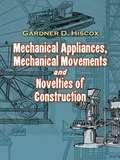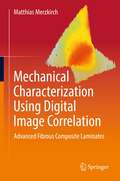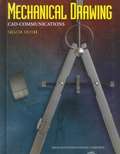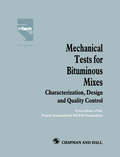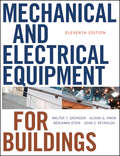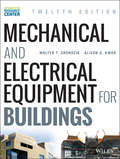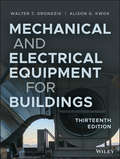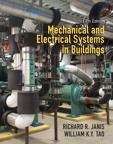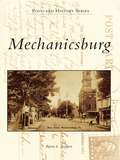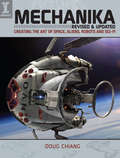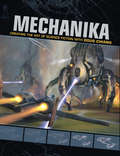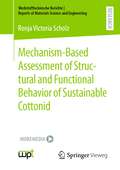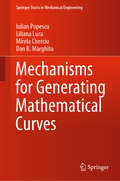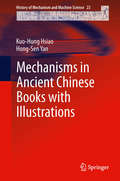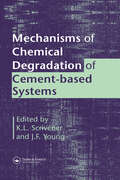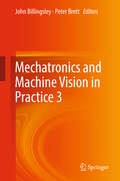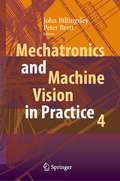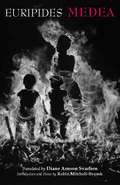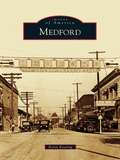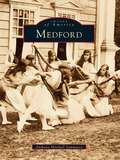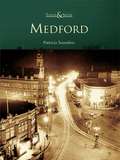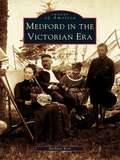- Table View
- List View
Mechanical Appliances, Mechanical Movements and Novelties of Construction
by Gardner D. HiscoxFrom the devices that power ships and trains to the workings of clocks, typewriters, and guns, this engrossing visual narrative profiles the specific and unique properties of hundreds of mechanical devices. Nearly 1,000 detailed illustrations depict steam-powered appliances, spring-powered devices, hydraulic equipment, and other machines, many of which remain in common use today. Each apparatus features a detailed line drawing and an informative explanation of its workings and uses. A final chapter chronicles 400 years of impassioned but futile searching for a perpetual motion machine.The companion to Dover's 1800 Mechanical Movements, Devices and Appliances, this volume features fewer but more complex machines than its predecessor. Today's readers--especially engineers, inventors, and other mechanically inclined individuals--will find endless fascination and inspiration among the novelty and variety of these ingenious mechanical designs.
Mechanical Characterization Using Digital Image Correlation: Advanced Fibrous Composite Laminates
by Matthias MerzkirchIn this book, a precise treatment of the experimental characterization of advanced composite materials using Digital Image Correlation (DIC) is presented. The text explains test methods, testing setup with 2D- and stereo-DIC, specimen preparation and patterning, testing analysis and data reduction schemes to determine and to compare mechanical properties, such as modulus, strength and fracture toughness of advanced composite materials. Sensitivity and uncertainty studies on the DIC calculated data and mechanical properties for a detailed engineering-based understanding are covered instead of idealized theories and sugarcoated results. The book provides students, instructors, researchers and engineers in industrial or government institutions, and practitioners working in the field of experimental/applied structural mechanics of materials a myriad of color figures from DIC measurements for better explanation, datasets of material properties serving as input parameters for analytical modelling, raw data and computer codes for data reduction, illustrative graphs for teaching purposes, practice exercises with solutions provided online and extensive references to the literature at the end of each stand-alone chapter.
Mechanical Drawing: CAD Communications (12th Edition)
by Thomas E. French Jay D. Helsel Carl L. Svensen Byron UrbanickThe nation's #1 drafting text – first published in 1919. The twelfth edition combines basic drafting elements and concepts with modern advancements in the technologies of the industry. Empowers students to move successfully from school to work by helping them visualize in three dimensions, build imaginations, think precisely, and understand the language of the industry.
Mechanical Drawing: CAD Communications (12th Edition)
by Thomas E. French Jay D. Helsel Carl L. Svensen Byron UrbanickThe nation's #1 drafting text – first published in 1919. The twelfth edition combines basic drafting elements and concepts with modern advancements in the technologies of the industry. Empowers students to move successfully from school to work by helping them visualize in three dimensions, build imaginations, think precisely, and understand the language of the industry.
Mechanical Tests for Bituminous Mixes - Characterization, Design and Quality Control: Proceedings of the Fourth International RILEM Symposium
by H. W. Fritz E. EustacchioThis book forms the Proceedings of an International RILEM Symposium, the fourth in the series, on Testing of Bituminous Mixes in Budapest, Hungary, October 1990. The aim of the Symposium is to promote tests for the characterization, design and quality control of bituminous mixes which combine the best features of traditional and modern approaches.
Mechanical and Electrical Equipment for Buildings
by Ben Stein Walter T. Grondzik John S. Reynolds Alison G. KwokFor more than half a century, this book has been a fixture in architecture and construction firms the world over. Twice awarded the AIA's Citation for Excellence in International Architecture Book Publishing, Mechanical and Electrical Equipment for Buildings is recognized for its comprehensiveness, clarity of presentation, and timely coverage of new design trends and technologies. Addressing mechanical and electrical systems for buildings of all sizes, it provides design guidelines and detailed design procedures for each topic covered. Thoroughly updated to cover the latest technologies, new and emerging design trends, and relevant codes, this latest edition features more than 2,200 illustrations--200 new to this edition--and a companion Website with additional resources.
Mechanical and Electrical Equipment for Buildings
by Walter T. Grondzik Alison G. KwokThe definitive guide to environmental control systems, updated with emerging technology and trendsThe Interactive Resource Center is an online learning environment where instructors and students can access the tools they need to make efficient use of their time, while reinforcing and assessing their understanding of key concepts for successful understanding of the course. An access card with redemption code for the online Interactive Resource Center is included with all new, print copies or can be purchased separately. (***If you rent or purchase a used book with an access code, the access code may have been redeemed previously and you may have to purchase a new access code ISBN: 978111899616-4).The online Interactive Resource Center contains resources tied to the book, such as:Interactive AnimationsInteractive Self-testsInteractive FlashcardsCase StudiesRespondus Testbank (instructors only)Instructor's Manual (over 200 pages) including additional resources (Instructors only)Roadmap to the 12th Edition (Instructors only)Student Guide to the TextbookMechanical and Electrical Equipment for Buildings, Twelfth Edition is the industry standard reference that comprehensively covers all aspects of building systems. With over 2,200 drawings and photographs, the book discusses basic theory, preliminary building design guidelines, and detailed design procedure for buildings of all sizes. The updated twelfth edition includes over 300 new illustrations, plus information on the latest design trends, codes, and technologies, while the companion website offers new interactive features including animations, additional case studies, quizzes, and more.Environmental control systems are the components of a building that keep occupants comfortable and help make the building work. Mechanical and Electrical Equipment for Buildings covers both active controls, like air conditioners and heaters, as well as passive controls like daylighting and natural ventilation. Because these systems comprise the entire energy use and costs of a building's life, the book stresses the importance of sustainability considerations during the design process, by both architects and builders. Authored by two leading green design educators, MEEB provides the most current information on low-energy architecture, including topics like:Context, comfort, and environmental resourcesIndoor air quality and thermal controlIllumination, acoustics, and electricityFire protection, signal systems, and transportationOccupant comfort and building usability are the most critical factors in the success of a building design, and with environmental concerns mounting, it's becoming more and more important to approach projects from a sustainable perspective from the very beginning. As the definitive guide to environmental control systems for over 75 years, Mechanical and Electrical Equipment for Buildings is a complete resource for students and professionals alike.
Mechanical and Electrical Equipment for Buildings: Wiley E-text Card And Interactive Resource Center Access Card
by Walter T. Grondzik Alison G. KwokThe definitive guide to the design of environmental control systems for buildings—now updated in its 13th Edition Mechanical and Electrical Equipment for Buildings is the most widely used text on the design of environmental control systems for buildings—helping students of architecture, architectural engineering, and construction understand what they need to know about building systems and controlling a building's environment. With over 2,200 drawings and photographs, this 13th Edition covers basic theory, preliminary building design guidelines, and detailed design procedure for buildings of all sizes. It also provides information on the latest technologies, emerging design trends, and updated codes. Presented in nine parts, Mechanical and Electrical Equipment for Buildings, Thirteenth Edition offers readers comprehensive coverage of: environmental resources; air quality; thermal, visual, and acoustic comfort; passive heating and cooling; water design and supply; daylighting and electric lighting; liquid and solid waste; and building noise control. This book also presents the latest information on fire protection, electrical systems; and elevator and escalator systems. This Thirteenth Edition features: Over 2,200 illustrations, with 200 new photographs and illustrations All-new coverage of high-performance building design Thoroughly revised references to codes and standards: ASHRAE, IES, USGBC (LEED), Living Building Challenge, WELL Building Standard, and more Updated offering of best-in-class ancillary materials for students and instructors available via the book’s companion website Architect Registration Examination® (ARE®) style study questions available in the instructor’s manual and student guide Mechanical and Electrical Equipment for Buildings, has been the industry standard reference that comprehensively covers all aspects of building systems for over 80 years. This Thirteenth Edition has evolved to reflect the ever-growing complexities of building design, and has maintained its relevance by allowing for the conversation to include ”why” as well as “how to.”
Mechanical and Electrical Systems in Buildings
by Richard R. Janis William K. Y. TaoThis extensively updated text and reference illuminates the modern realities of planning and constructing buildings with efficient, sustainable mechanical and electrical systems. Throughout, the authors place mechanical and electrical systems design in the overall context of the built environment. They extensively address engineers' teamwork with architects, owners, and facility managers to provide high-quality, productive environments which reflect both environmental and cost concerns. Focusing on the "what," "why," and "how" of ME systems, they incorporate new developments in all major disciplines, including electrical, lighting, telecom, plumbing and HVAC. New coverage in this edition includes: HVAC design using VRF and chilled beam technologies; energy reclaim systems; dedicated outside air systems; assessment of solar thermal system efficiency; new fuel cell technology; updates on the economics of cogeneration, and much more.
Mechanicsburg
by Byron L. ReppertMechanicsburg, nestled in Cumberland County midway between Harrisburg, the state capital, and Carlisle, the county seat, was once known as Drytown, Pinchgut, and Stauffertown. Incorporated in 1828 and named for a settlement of mechanics that repaired Conestoga wagons, Mechanicsburg was raided by the Confederates and held for three days during the Civil War. Both the Cumberland Valley Railroad and the development of the inland Naval Support Activity Base influenced the rapid growth of this borough. Since 1924, Mechanicsburg has played host to Jubilee Day, Pennsylvania's largest one-day street fair.
Mechanika, Revised and Updated: Creating the Art of Space, Aliens, Robots and Sci-Fi
by Doug ChiangYou can design the future!In a post-apocalyptic alien landscape, starfighters crash land in desert terrain, dino riders rear up, rusted crab walkers litter the horizon and men work with--or fight against--giant iron robots. You control it all and Academy Award-winning sci-fi film production designer Doug Chiang tells you how. In this revised and updated version of his best-selling book, Mechanika, Chiang uses his 25 years in the film industry working on such films as the Star Wars franchise, Terminator 2: Judgment Day and War of the Worlds to teach you the techniques, tools and tips to draw and think like a master sci-fi artist.Inside you'll find:The six keys to good design and how to build an expert toolkit.Basic sketching techniques and the rules of perspective--even in imaginary worlds.25+ step-by-step demonstrations showing how to draw everything from monopods and labor beasts to aliens and steam-powered robots by mixing traditional drawing and marker techniques with digital painting technology.How to create compelling science fiction scenes inspired by movies, books, comics and games from conceptualization to completion.Tips and details on how to use Adobe Photoshop to design, draw and enhance your creations--including author secrets!Learn design secrets from one of the sci-fi artists behind Star Wars, War of the Worlds and Terminator 2: Judgment Day!
Mechanika: Creating the Art of Science Fiction with Doug Chiang
by Doug ChiangDelve into a world of imagination populated with giant robots, strange vehicles, alien creatures and other fantastic inventions. For generations artists have created imagery destined for the entertainment of others, and now you can too.Revered science fiction artist and film designer, Doug Chiang, reveals the thought processes and techniques he used working on blockbusters such as the Star Wars prequels, War of the Worlds, Terminator, and Beowulf. You'll learn from Chiang's visionary experience as he shares his design processes, giving expert advice and showcasing the groundbreaking style that has earned his creations a spot in the Brooklyn Museum, Houston Museum of Fine Art and the Tokyo National Museum.Inside you'll discover:30+ lessons for creating out-of-this-world science fiction scenes in the style featured in films, books, comics, toys and games using both traditional and digital techniquesDetails and tips for using Adobe Photoshop to conceive, design, draw and enhance your creations25 step-by-step demonstrations of outrageous robots, vehicles, creatures and environments with finished color imagesForeword by film producer/director Robert Zemeckis (Monster House, The Polar Express, Back to the Future, Beowulf)With tips on everything from basic skills like blueline sketching and assembling a toolkit to conceptualization and painting for digital art, Mechanika has everything you need to get great results and make your science fiction worlds come alive!
Mechanism-Based Assessment of Structural and Functional Behavior of Sustainable Cottonid (Werkstofftechnische Berichte │ Reports of Materials Science and Engineering)
by Ronja Victoria ScholzRonja Victoria Scholz assesses the performance of cellulose-based Cottonid for implementation as sustainable construction material. Quasi-static and fatigue tests are performed in varying hygrothermal test conditions using mechanical testing systems in combination with integrable climate chambers. To investigate humidity-driven actuation properties, customized specimen holders are designed. Accompanying microstructural in situ experiments in analytical devices enable a profound understanding of effective material-specific damage and failure mechanisms. The findings are transferred into strength-deformation diagrams as well as Woehler curves, which enable a comparative evaluation of several process-related and environmental influencing factors and can directly be used for dimensioning of Cottonid elements for structural applications. The interpretation of thermoelastic material reponse during loading is used as scientific value for lifetime prediction. Comprehensive investigations on industrial standard materials as well as structurally optimized Cottonid variants provide a scientific basis for categorizing material’s structural and functional performance towards common technical plastics and wood.
Mechanisms for Generating Mathematical Curves (Springer Tracts in Mechanical Engineering)
by Dan B. Marghitu Iulian Popescu Liliana Luca Mirela CherciuThis book focuses on important mathematical considerations in describing the synthesis of original mechanisms for generating curves. The synthesis is manual and not based on the use of computer tools. Kinematics is applied to confirm the drawing of the curves, and the closed loop method, and in some cases the distances method, is applied in this phase. The book provides all the notions of structure and kinematics that are necessary to calculate the mechanisms and also analyzes other kinematic possibilities of the created mechanisms. Offering a concise, yet self-contained guide to the mathematical fundamentals for mechanisms of curve generation, together with a useful collection of mechanisms exercises, the book is intended for students learning about mechanism kinematics, as well as engineers dealing with mechanism design and analysis. It is based on the authors’ many years of research, which has been published in different books and journals, mainly, but not exclusively, in Romanian.
Mechanisms in Ancient Chinese Books with Illustrations
by Hong-Sen Yan Kuo-Hung HsiaoThis book presents a unique approach for studying mechanisms and machines with drawings that were depicted unclearly in ancient Chinese books. The historical, cultural and technical backgrounds of the mechanisms are explained, and various mechanisms described and illustrated in ancient books are introduced. By utilizing the idea for the conceptual design of modern mechanisms, all feasible designs of ancient mechanisms with uncertain members and joints that meet the technical standards of the subjects' time periods are synthesized systematically. Ancient Chinese crossbows (the original crossbow and repeating crossbows), textile mechanisms (silk-reeling mechanism, spinning mechanisms, and looms), and many other artisan's tool mechanisms are used as illustrated examples. Such an approach provides a logical method for the reconstruction designs of ancient mechanisms with uncertain structures. It also provides an innovative direction for researchers to further identify the original structures of mechanisms and machines with drawings in ancient literature. This book can be used as a textbook and/or supplemental reading material for courses related to history of ancient (Chinese) machinery and creative mechanism design for senior and graduate students.
Mechanisms of Chemical Degradation of Cement-based Systems
by K. L. Scrivener J. F. YoungDeterioration of cement-based materials is a continuing problem, as it results in the substantial shortening of the lives of conventional concrete structures. The main costs result from poor performance and the need for early repair. With more advanced applications, where very long service lives are essential, such as the storage of nuclear waste,
Mechatronics and Machine Vision in Practice 3
by John Billingsley Peter BrettIn contrast with previous books on mechatronics and machine vision in practice, a significant number of chapters focus on systems designed for human interaction and deciphering human motion. Examples illustrate assistive actuation of hip joints, the augmentation of touch sense in artificial hand prostheses and helping stroke survivors in repetitive motion therapy. Interactive mechatronics and the experience of developing machine interfaces has enabled an examination of how we use mechatronics in the service of training, and even to consider why computer games perhaps appear to capture attention so much more readily than a human instructor! Mechatronics continues to be an exciting and developing field. It is now an essential part of our world and living experience. This and the previous books in this series illustrate the journey in developing the use of mechatronics so far. We anticipate that you will find the chapters here an equal source of inspiration for new devices to solve the challenges of new applications, and of course as a resource for teaching and inspiring the new generation of mechatronics engineers.
Mechatronics and Machine Vision in Practice 4 (Robotics And Mechatronics Ser. #Vol. 4)
by John Billingsley Peter BrettThe many intriguing examples on the application of mechatronics reinforce the excitement of this creative field of technology. As a collection they present a stimulating resource to developers of future mechatronics technology, and to educators searching for interesting examples. From structured-light measurement of the build-up of detritus on railway bogies and detection of uncracked spores of Chinese medicine to a practical tractor vision guidance system embedded in a smart-phone application, the practical applications of mechatronics and machine vision abound. Fruits are counted on the tree, pasture biomass is measured and a robot collects camel dung as a resource. 3D printing is in vogue, but papers here discuss the construction and strategy of the printer itself. The measurement and analysis of myoelectric muscle signals enable a prosthesis to be controlled and a feeding robot is used for patient care. An exoskeleton has both soft and rigid links and an optical sensor analyses the tissue into which a surgical needle is being inserted. These are some of the papers in this collection from the 26th annual conference on Mechatronics and Machine Vision in Practice, carefully selected to exclude papers that are merely theoretical and to highlight those that show practical verification. Papers have been contributed from China, New Zealand, the Philippines, Emirates, Germany and of course Australia.
Medea
by Euripides Diane Arnson Svarlien Robin Mitchell-BoyaskThis is the Medea we have been waiting for. It offers clarity without banality, eloquence without pretension, meter without doggerel, accuracy without clumsiness. No English Medea can ever be Euripides', but this is as close as anyone has come so far, and a good deal closer than I thought anyone would ever come. Arnson Svarlien has shown herself exceedingly skillful in making Euripides sound Euripidean.--David M. Schaps, Bryn Mawr Classical Review
Medea
by Euripides Diane Arnson Svarlien Robin Mitchell-BoyaskThis is the Medea we have been waiting for. It offers clarity without banality, eloquence without pretension, meter without doggerel, accuracy without clumsiness. No English Medea can ever be Euripides', but this is as close as anyone has come so far, and a good deal closer than I thought anyone would ever come. Arnson Svarlien has shown herself exceedingly skillful in making Euripides sound Euripidean.--David M. Schaps, Bryn Mawr Classical Review
Medford
by Kevin KeatingIradell Phipps and Conrad Broback saw a golden opportunity in 1884. After convincing the railroad to build its depot on their prairie land near Bear Creek, they began building what became the second-fastest growing city in America, with over 100 new buildings in its first year. Few Medfordites today know that the city once had four separate railroads and was renowned throughout Europe. Intrepid flyers Eugene Ely, Pat Patterson, Seely Hall, and Charles Lindbergh made Medford a regional air hub during the early days of flight. In 1910, Medford had more automobiles per capita than any town in the world, and in 1923, it straddled the world's longest paved road. Told through photographs, facts, and anecdotes, the story of the hometown of film and radio stars Pinto Colvig and Ginger Rogers, as well as sports greats like Dick Fosbury, Bill Bowerman, and Kyle Singler, is a captivating read.
Medford (Images of America)
by Anthony Mitchell SammarcoReferred to in its beginning as a "peculiar town," Medford was originally a town but a plantation owned by Governor Matthew Craddock. Known as Meadford at the time of its settlement in 1630, the area was a flourishing village located along the Mystic River that boasted numerous farms, fisheries, and shipbuilding. A small town for the first two centuries after it was settled, Medford was conveniently located only a few miles from Boston. Its prime location soon attracted thousands of residents, and by the turn of the twentieth century, Medford had become a cultural mecca with over 18,000 residents. The town's strong sense of community and respect for diversity has continued through the years, transforming a small fishing and farming village into one of the finest residential communities in metropolitan Boston. In Medford, author Anthony Mitchell Sammarco invites his readers to join him on a journey back in time to an earlier Medford, when local transportation meant a ride on a horse-drawn streetcar or a train ride on the Boston & Lowell line. Within these pages, learn little-known facts about the founding of renowned institutions such as Tufts University, view candid snapshots of early Medford residents at work and at play, and discover rare photographs of the area's more unusual influences, from the exotic foods and customs introduced by European settlers to the impact of the town's gypsy moth dilemma.
Medford (Then and Now)
by Patricia SaundersMedford, originally referred to as Meadford, was settled as a plantation in 1630 by Gov. Matthew Craddock. A historic city located on the Mystic River in Middlesex County, Medford gained fame from its clipper ships, crackers, and rum. The song "Jingle Bells" was composed here by James Pierpoint in the early 1850s. Many prominent citizens have lived in Medford, including Amelia Earhart, who moved to the city in 1924. Medford, part of the Then & Now series, connects this city's past with its present by comparing historic and modern photographs of sites such as the Royall House, Jonathan Wade House, and Peter Tufts-Craddock House.
Medford in the Victorian Era (Images of America)
by Barbara KerrWhen the Boston and Lowell Railroad came through in 1835, Medford was a quiet town with fewer than two thousand residents. By the twentieth century, it had become a thriving city of eighteen thousand. In Victorian Medford, everything was new, from the Medford Opera House, the town hall, and the Mystic Lakes to the camera, the bicycle, and the gypsy moth. The shipbuilding, rum, and brickmaking industries gave way to new businesses, and traditional houses came to share neighborhoods with Queen Anne and Shingle-style architecture. In the mid-nineteenth century, there was great social change, as abolitionists Lydia Maria Child and George Luther Stearns spoke out against slavery and men went to the Civil War. James W. Tufts invented the soda fountain, Fannie Farmer wrote her first cookbook, and James Pierpont wrote "Jingle Bells."
Media Activism, Artivism and the Fight Against Marginalisation in the Global South: South-to-South Communication (Media and Communication Activism)
by Andrea Medrado Isabella RegaThis book analyses a South-to-South connection between media activists and artivists – artists who are activists – in the Global South. The authors, Andrea Medrado and Isabella Rega, emphasise the urgent need to engage in South-to-South dialogues in order to create more sustainable connections between Global South communities and as an essential step towards identifying and facing global problems, such as state repression, social inequality and climate crises. Medrado and Rega analyse the characteristics of this connection, identify its unique contributions to the study of media and social change and discuss its long-term sustainability. They do so by focusing on instances when media narratives in countries of different Global South(s) intertwine and transform each other; specifically, the exchanges between Latin America (Brazil) and Africa (Kenya). They explore how media activism and artivism can be used as tools for global movement building and to challenge colonial legacies. They also discuss how to connect people with varied skill sets in different Global South contexts, promoting South-to-South solidarity, in a cross-continental challenge to marginalisation. Crucial reading for students and scholars of media activism, social movements, global media and communication, development studies and international studies, as well as activists and social movement organisations.
